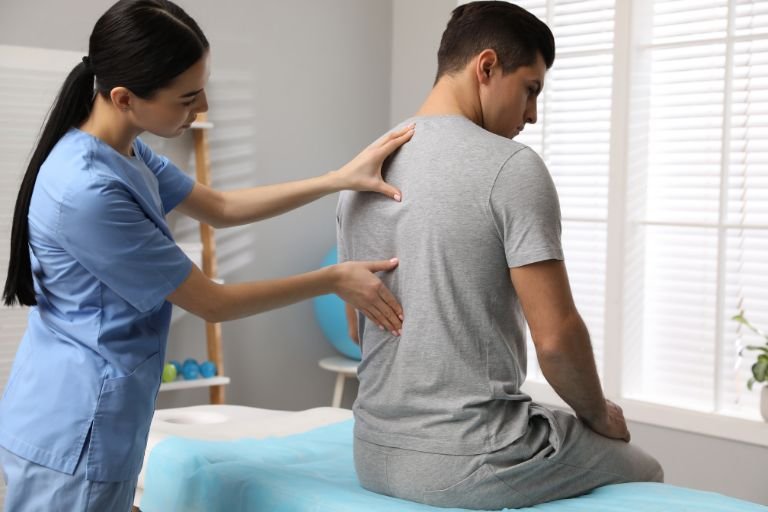- Fitwell Physiotherapy
Elbow & Wrist Pain

Elbow and wrist pain refer to discomfort or pain experienced in the joints or surrounding tissues of the elbow and wrist. These conditions can result from various factors, including injuries, repetitive strain, inflammation, and underlying health conditions. Understanding the nature of elbow and wrist pain involves recognizing the common causes, symptoms, and treatment options associated with these types of pain.
Please submit your details below.
Symptoms
Elbow and wrist pain can manifest in various ways, often depending on the underlying cause. Common symptoms include:
Elbow Pain:
- Tenderness around the joint
- Swelling
- Stiffness or reduced range of motion
- Difficulty in gripping objects
- Pain that worsens with certain activities, such as lifting or twisting the arm
Wrist Pain:
- Pain or tenderness in the wrist
- Swelling around the wrist
- Stiffness or difficulty in moving the wrist
- Weakness in the hand
- Numbness or tingling, especially if nerves are involved
Causes
Several conditions can lead to elbow and wrist pain, including:
Elbow Pain:
- Tennis Elbow (Lateral Epicondylitis): Inflammation of the tendons on the outer side of the elbow, usually due to repetitive motion.
- Golfer’s Elbow (Medial Epicondylitis): Similar to tennis elbow but affects the inner side of the elbow.
- Bursitis: Inflammation of the bursa, a small fluid-filled sac that cushions the elbow joint.
- Arthritis: Inflammation of the elbow joint, common in osteoarthritis or rheumatoid arthritis.
- Fractures: Breaks or cracks in the bones around the elbow due to trauma.
Wrist Pain:
- Carpal Tunnel Syndrome: Compression of the median nerve as it passes through the carpal tunnel in the wrist.
- Tendonitis: Inflammation of the tendons around the wrist, often from overuse.
- Ganglion Cysts: Noncancerous lumps that can develop along the tendons or joints of the wrists.
- Arthritis: Degenerative changes in the wrist joints.
- Sprains and Fractures: Injuries from falls, impacts, or overuse.
When to See a Physiotherapist
You should consider seeing a physiotherapist if you experience:
- Persistent or worsening pain despite rest and home treatment
- Significant swelling or bruising
- Difficulty performing everyday tasks
- Numbness or tingling, indicating possible nerve involvement
- Pain that is affecting your quality of life or sleep
Risks
Ignoring elbow and wrist pain or delaying treatment can lead to:
- Chronic pain and discomfort
- Reduced mobility and function
- Muscle weakness and atrophy
- Development of compensatory movement patterns, potentially causing issues in other parts of the body
- Permanent damage in severe cases of untreated fractures or nerve compression
How to Prevent
Preventing elbow and wrist pain involves a combination of lifestyle modifications and exercises:
- Ergonomics: Ensure proper workstation setup to reduce strain on your wrists and elbows.
- Regular Breaks: Take frequent breaks from repetitive tasks, especially if they involve heavy use of the hands and arms.
- Strengthening Exercises: Incorporate exercises that strengthen the muscles around your elbow and wrist.
- Stretching: Regularly stretch your arms and hands to maintain flexibility.
- Proper Technique: Use correct techniques when lifting or performing repetitive motions.
- Protective Gear: Use wrist guards or elbow pads during activities that pose a risk of injury.
Treatments
Treatment options for elbow and wrist pain vary based on the underlying cause:
- Rest and Immobilization: Allow the affected area to heal by avoiding activities that cause pain. Splints or braces can help immobilize the joint.
- Ice and Heat Therapy: Apply ice to reduce swelling and heat to relax muscles and improve blood flow.
- Medication: Over-the-counter pain relievers, such as ibuprofen or acetaminophen, can help manage pain and inflammation.
- Physical Therapy: A physiotherapist can provide exercises to improve strength, flexibility, and range of motion.
- Injections: Corticosteroid injections can reduce inflammation in severe cases.
- Surgery: In cases of severe injury or when conservative treatments fail, surgical intervention may be necessary.
Conclusion
Elbow and wrist pain can significantly impact daily life, but early intervention and appropriate treatment can lead to effective management and recovery. Preventive measures, such as ergonomic adjustments and regular exercises, play a crucial role in maintaining joint health and preventing future injuries. If you experience persistent or severe pain, seeking professional advice from a physiotherapist is essential for accurate diagnosis and effective treatment
Frequently Asked Questions
Foot pain can result from various factors, including:
- Plantar fasciitis: inflammation of the tissue connecting the heel to the toes.
- Achilles tendonitis: inflammation of the Achilles tendon at the back of the heel.
- Morton’s neuroma: thickening of tissue around a nerve between the toes.
- Bunions or hammertoes: deformities of the foot bones.
- Sprains, strains, or fractures.
- Arthritis.
- Overuse or repetitive stress injuries.
- Ill-fitting shoes or poor footwear choices.
Physiotherapy can offer various treatments to alleviate foot pain, including:
- Manual therapy techniques like massage and joint mobilization to reduce pain and improve joint mobility.
- Strengthening and stretching exercises to improve foot and ankle strength, flexibility, and stability.
- Gait analysis and correction to address abnormal walking patterns contributing to foot pain.
- Custom orthotics or footwear recommendations to provide support and relieve pressure on affected areas.
- Modalities such as ultrasound or electrical stimulation to reduce inflammation and promote healing.
You should consider seeking physiotherapy if foot pain:
- Persists for more than a few days despite rest and home remedies.
- Interferes with daily activities or mobility.
- Is severe or accompanied by swelling, redness, or signs of infection.
- Recurs frequently or worsens over time.
- Is associated with a recent injury or trauma.
At-home remedies to relieve foot pain include:
- Resting and elevating the affected foot.
- Applying ice packs to reduce inflammation.
- Taking over-the-counter pain medications.
- Stretching and massaging the foot.
- Wearing supportive footwear with cushioned insoles.
- Avoiding activities that exacerbate the pain.
Preventive measures to reduce the risk of foot pain include:
- Wearing properly fitted shoes with adequate support.
- Maintaining a healthy weight to reduce pressure on the feet.
- Gradually increasing physical activity to avoid overuse injuries.
- Stretching and strengthening exercises for the feet and ankles.
- Regularly inspecting the feet for signs of irritation or injury.
Related Symptoms
How Fitwell Physiotherapy Can Help?
Dr. Richa’s Fitwell physiotherapy has an extensive team of physiotherapists all within their own specialist areas of physiotherapy. Whatever your condition, we guarantee that we will have the best physiotherapist for you. We assess, diagnose, plan, cure and care for you.
Fitwell Physiotherapy Clinic, Pune provides you best physiotherapy treatment in Kharadi, pune. We also serve Chandan Nagar, Vadgaon Sheri, Keshav Nagar, Wagholi & nearby Areas in Pune. We are experts in treating Neck Pain, Hand Pain, Back Pain, Lower Back Pain, Knee Pain, Stiff Neck, Sciatica, Arthritis, Stroke Paralysis & Post Surgical Rehab.
We provide Specialized physiotherapy treatments in Sports Injuries, Pre and post Surgery, Neurologic, Pediatric, Chronic Pain/Fatigue, Rheumatology, Women’s Health, Men’s Health, Ergonomics, Vestibular, Amputees & all sort of Pain treatment and lifestyle conditions.
































